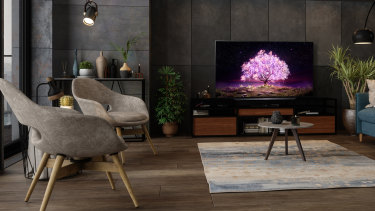
If you’ve ever been shopping for the best TV you could reasonably afford, poring over spec sheets and making comparisons and (in the before times) going store to store to check them out in the flesh, you’ve probably noticed that the most advanced TVs are often the biggest TVs. Which isn’t ideal if you’re trying to get high-end home cinema into a less-than-cavernous space.
To start with, OLED TVs are hard to come by in anything smaller than 55 inches (137.5cm), and OLED really makes a difference to colour, contrast and clarity. And regardless of panel type, manufacturers tend to remove or water down features on their various models as they get smaller. This means the reasonably sized version may have inferior uniformity, worse viewing angles, fewer inputs or less sophisticated software, even if it has the same name as its larger siblings.

The LG C1 comes in huge sizes to suit the aspirational spaces seen in promotional photos, but also in a small size to suit regular homes.
That’s why it’s been such an unexpected pleasure for me to test out the 48-inch version of LG’s flagship C1 OLED. Not only is it one of the smallest OLED TVs you can currently get (though hardly insubstantial at a little more than a metre wide), it also has all the same features of the bigger C1 models, meaning you get all the technology of one of the most advanced TVs on the market in a compact apartment- or bedroom-friendly package. And while the insane 83-inch C1 costs more than $10,000, the 48-incher comes in at around $2400.
Like the bigger C1 the 48-inch model is a thin and svelte-looking unit, although a higher proportion of its overall mass is made up by the stand and processing area at the bottom, so it’s not quite as visually impressive. Under the hood, though, it’s just as much of a powerhouse.
The picture is stunning and doesn’t degrade when viewed from an angle, while its ability to process and upscale lower-resolution images to 4K is the most effective I’ve seen on any TV. HD Blu-rays from more than 10 years ago look razor sharp, and the C1 does what it can with standard definition broadcasts as well.
Even sources that challenge many TVs — such as cinematic 24 frame-per-second movies or fast-moving sports broadcasts — are taken in stride, as judder and blurring are smartly counteracted by inserting or interpolating frames. You will need to spend some time working out what the various picture settings do to get them just right though.
Loading
Of course things look best with a 4K HDR source, and the C1 supports Dolby Vision for the most immersive-looking modern film and TV. All four of the HDMI inputs here are the latest version 2.1, which is extremely rare even among high-end TVs. It might not mean much to you now, but the improved spec allows for a lot more data to flow through the cable, making it easier to get higher resolutions, higher frame rates and more complex sound from the devices plugged into your TV all at the same time.
The C1 also supports eARC, meaning it can pass full Dolby Atmos audio signals to your soundbar or receiver, making it simple to get the absolute best video and audio from every app and device.



























